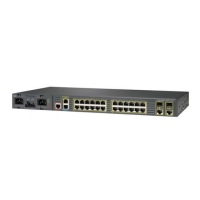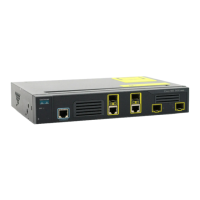42-16
Cisco ME 3400 Ethernet Access Switch Software Configuration Guide
OL-9639-07
Chapter 42 Configuring IP Multicast Routing
Configuring IP Multicast Routing
even with SSM, use a different group for each television (S, G) channel. This setup guarantees that
multiple receivers to different channels within the same application service never experience traffic
aliasing in networks that include Layer 2 switches.
IGMP Snooping and CGMP Limitations
IGMPv3 uses new membership report messages that might not be correctly recognized by older IGMP
snooping switches.
For more information about switching issues related to IGMP (especially with CGMP), refer to the
“Configuring IGMP Version 3” section of the “Configuring IP Multicast Routing” chapter.
State Maintenance Limitations
In PIM-SSM, the last hop router continues to periodically send (S, G) join messages if appropriate (S,
G) subscriptions are on the interfaces. Therefore, as long as receivers send (S, G) subscriptions, the
shortest path tree (SPT) state from the receivers to the source is maintained, even if the source does not
send traffic for longer periods of time (or even never).
This case is opposite to PIM-SM, where (S, G) state is maintained only if the source is sending traffic
and receivers are joining the group. If a source stops sending traffic for more than 3 minutes in PIM-SM,
the (S, G) state is deleted and only re-established after packets from the source arrive again through the
RPT. Because no mechanism in PIM-SSM notifies a receiver that a source is active, the network must
maintain the (S, G) state in PIM-SSM as long as receivers are requesting receipt of that channel.
Configuring SSM
Beginning in privileged EXEC mode, follow these steps to configure SSM:
Monitoring SSM
Use the commands in Table 42-3 to monitor SSM.
Command Purpose
Step 1
ip pim ssm [default | range access-list] Define the SSM range of IP multicast addresses.
Step 2
interface type number Select an interface that is connected to hosts on which
IGMPv3 can be enabled, and enter the interface configuration
mode.
Step 3
ip pim {sparse-mode | sparse-dense-mode} Enable PIM on an interface. You must use either sparse mode
or sparse-dense mode.
Step 4
ip igmp version 3 Enable IGMPv3 on this interface. The default version of
IGMP is set to Version 2.
Ta b l e 42-3 Monitoring SSM
Command Purpose
show ip igmp groups detail Display the (S, G) channel subscription through IGMPv3.
show ip mroute Display whether a multicast group supports SSM service or
whether a source-specific host report was received.

